Hearth and Home Technologies GNBC33, GNBC36, GNBC30 User Manual
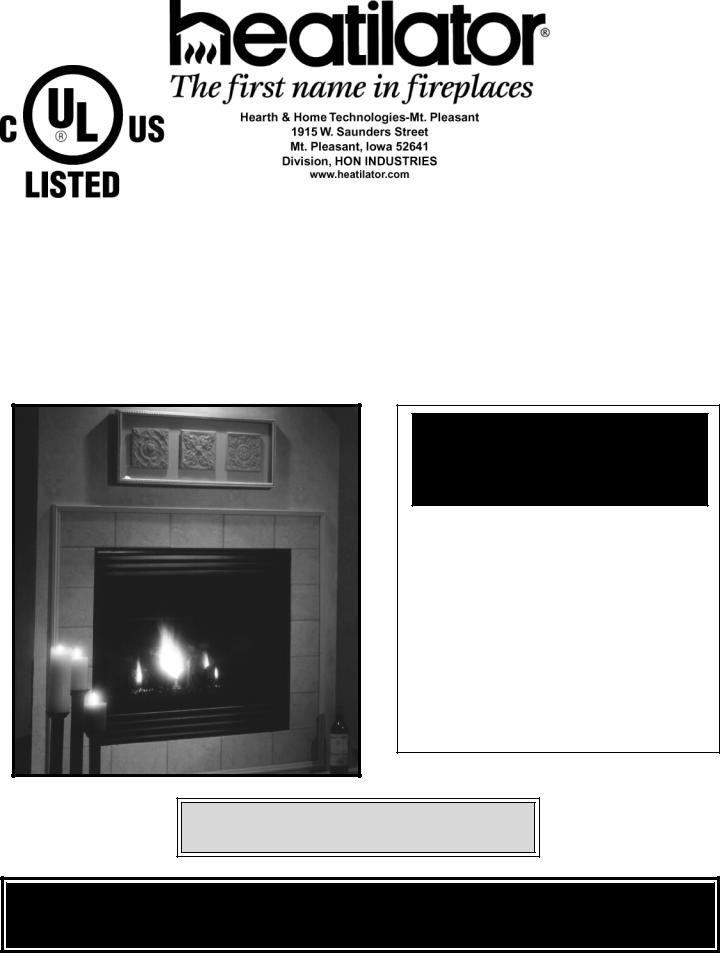
INSTALLATION & OPERATING
INSTRUCTIONS
NOVUS SERIES
B-VENT GAS APPLIANCE
GNBC30, 33, & 36
WARNING: If the information in this manual is not followed exactly, a fire or explosion may result causing property damage, personal injury or loss of life.
— Do not store or use gasoline or other flammable vapors and liquids in the vicinity of this or any other appliance.
— What to do if you smell gas
• Do not try to light any appliance.
• Do not touch any electrical switch; do not use any phone in your building.
• Immediately call your gas supplier from a neighbor’s phone. Follow the gas supplier’s instructions.
• If you cannot reach your gas supplier, call the fire department.
— Installation and service must be performed by a qualified installer, service agency or the gas
CAUTION:
Do not expose appliance to the elements (such as rain, etc.).
WARNING!
Improper installation, adjustment, alteration, service or maintenance can cause injury or property damage. Refer to this manual. For assistance or additional information, consult a qualified installer, service agency or the gas supplier.
12-02 |
1 |
34615 Rev G |
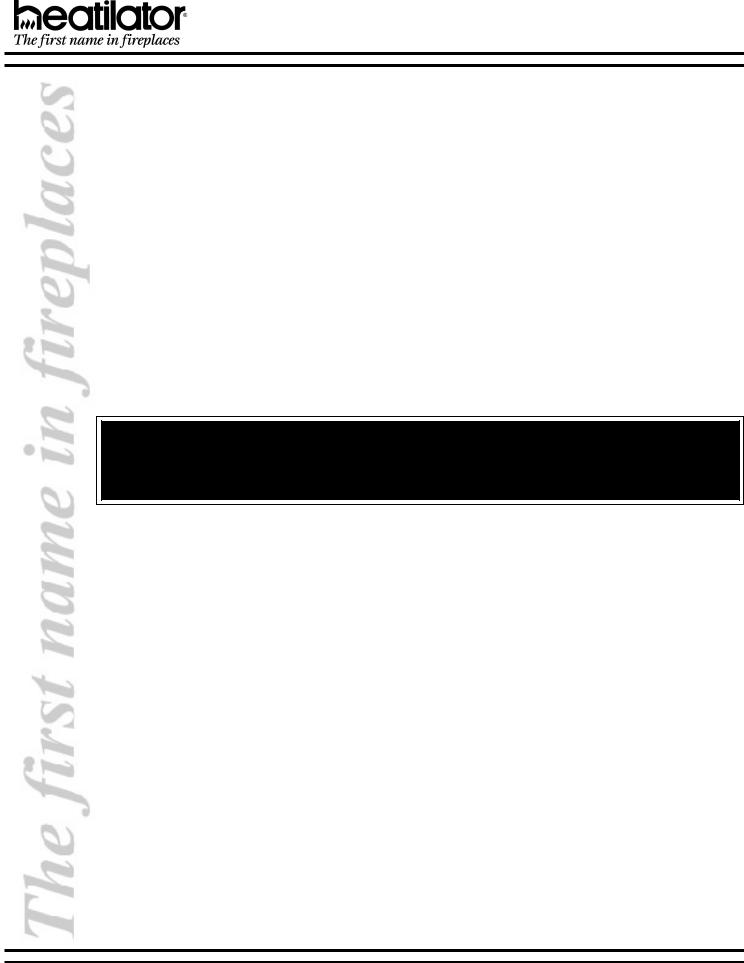
|
NOVUS B-VENT INSTALLATION INSTRUCTIONS |
|
|
TABLE OF CONTENTS |
|
|
Design and Installation Considerations for B-Vents ...................................................................................................... |
3 |
A. |
Applicance Specifications ............................................................................................................................................ |
4 |
B. |
Location and Clearances .............................................................................................................................................. |
5 |
C. |
Framing ......................................................................................................................................................................... |
6 |
D. |
Setting the Appliance .................................................................................................................................................... |
7 |
E. |
Venting ........................................................................................................................................................................... |
7 |
F. |
Utilities .......................................................................................................................................................................... |
11 |
G. |
Finishing ...................................................................................................................................................................... |
14 |
H. |
Appliance Preparation ................................................................................................................................................ |
14 |
I. |
Determining the Ignition Type ..................................................................................................................................... |
15 |
J. |
Lighting Instructions .................................................................................................................................................... |
16 |
K. |
Seasonal Checklist ...................................................................................................................................................... |
18 |
L. |
Start-up Issues ............................................................................................................................................................ |
19 |
M. |
Maintenance Instructions ............................................................................................................................................ |
20 |
N. |
Optional Components ................................................................................................................................................. |
22 |
O. |
Replacement Parts ...................................................................................................................................................... |
25 |
|
Index ............................................................................................................................................................................ |
27 |
|
Warranty ...................................................................................................................................................................... |
28 |
WARNING!
DO NOT use this appliance if any part has been under water. Immediately call a qualified service technician to inspect the appliance and to replace any part of the control system and any gas control which has been under water.
SAFETY PRECAUTIONS
1.Please read these installation instructions completely before beginning installation procedures. Failure to follow them could cause an appliance malfunction resulting in serious injury and/or property damage.
2.Always check your local building codes prior to installation. This installation must comply with all local, regional, state and national codes and regulations.
3.Installation and repair should be done by a qualified service person. This appliance should also be inspected annually by a qualified service person. More frequent inspections/cleaning may be required due to excessive lint from carpeting, bedding materials, etc. It is imperative that the control compartment, burners and circulating air passageways of the appliance be kept clean.
4.This is a vented decorative gas appliance. Do not burn wood or other material in this appliance.
5.NEVER leave children unattended when there is a fire burning in the appliance.
6.This appliance may only use the approved venting systems shown in these installation instructions. Venting must not be connected to chimney flue servicing a solid fuel burning appliance or a gas fuel burning appliance.
7.NEVER use gasoline, gasoline-type lantern fuel, kerosene, charcoal lighter fluid, or similar liquids in this appliance. Keep any flammable liquids a safe distance from the appliance.
8.While servicing this appliance, always shut off all electricity and gas to the appliance. This will prevent possible electrical shock or burns. Also, make sure the appliance is completely cooled before servicing.
9.Do not use this appliance if any part has been under water. Immediately call a qualified service technician to inspect the appliance and to replace any part of the control system and any gas control which has been under water.
10.Be sure to provide adequate clearances around the air openings into the combustion chamber and adequate accessibility clearances for servicing and proper operation.
34615 Rev G |
2 |
12-02 |
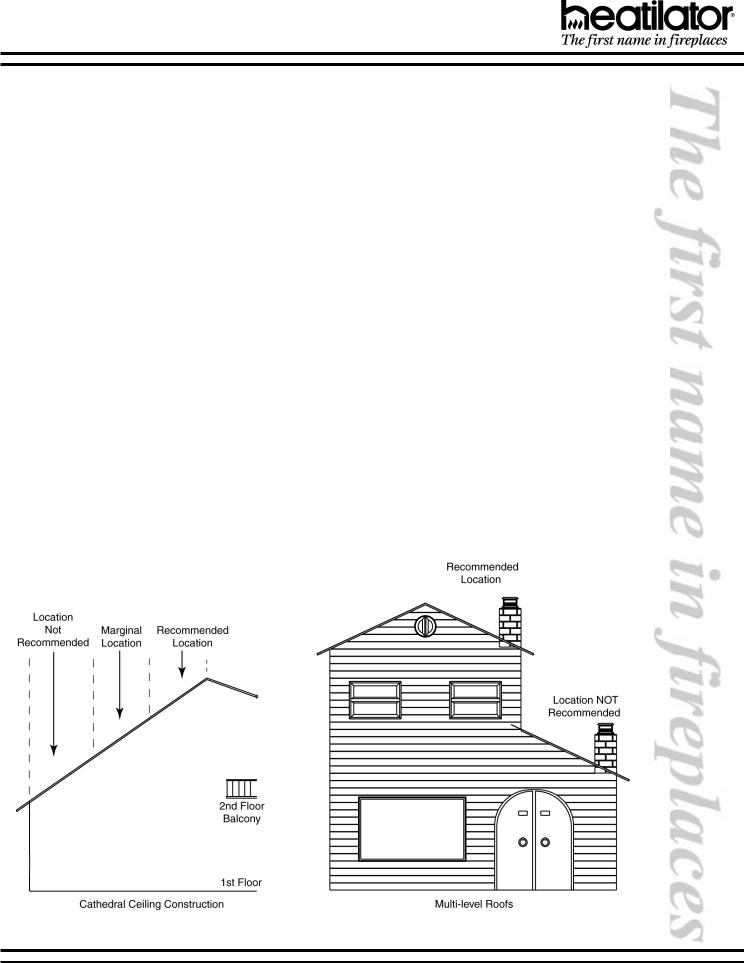
NOVUS B-VENT INSTALLATION INSTRUCTIONS
DESIGN AND INSTALLATION CONSIDERATIONS FOR B-VENTS
When selecting a location for your B-Vent appliance, it is important to evaluate a number of considerations. Modern construction techniques can create conditions that may not allow your vent to draft properly. This may result in spillage from your B-Vent appliance, as well as cause other combustion appliances to operate incorrectly.
Tightly sealed construction is important for energy efficiency. Unfortunately, a great deal of effort has been directed to tightening up sidewall construction, while considerably less attention has been paid to tightening upper portions of the warm air envelope (insulated ceilings). This has increased the “Stack Effect”, a condition that increases the negative pressure generated by the structure. This negative pressure will directly affect the drafting performance of a B-Vent appliance vent. To minimize the negative pressure generated by stack effect, make certain that all ductwork installed in the attic spaces is sealed airtight. Minimize the number of recessed light fixtures installed in the insulated ceiling and use sealed recessed light fixtures. Finally, make certain the whole house fans and attic access panels are tightly sealed. These are important design considerations that must be observed during the design and construction stage of the home.
If you desire to put an appliance in your basement, we recommend that you consider a direct vent gas appliance. Basements always have a significant negative air pressure that causes the B-Vent system to be more susceptible to spillage and cold flue backdrafting. Since direct vent gas appliances are sealed, they are not affected by the negative pressure that exists in basements.
Finally, a B-Vent appliance performs best when the vent (roof termination) is located on the upper half of the roof, especially when cathedral ceilings are present. Vents that are located on the lower half of the roof realize what is known as “lazy flue” and will not draft as well as a vent that is located in the upper portion of the roof. The reason for this is that the stack effect generated by the overall height of the living spaces inside the house will exceed the draft generated by the vent system. If you desire to place an appliance in a location where the termination cap would be located on the lower half of a roof; such as on an outside wall at the base of a cathedral ceiling, we recommend that you consider using a direct vent gas appliance. This will ensure an appliance that operates correctly.
These properties do not affect just your B-Vent appliance. They can cause any woodburning fireplace as well as any conventionally vented (B-Vent) gas appliance to operate improperly. Careful planning at this stage of your project will ensure satisfaction with the operation of your appliance once it is completed.
12-02 |
3 |
34615 Rev G |
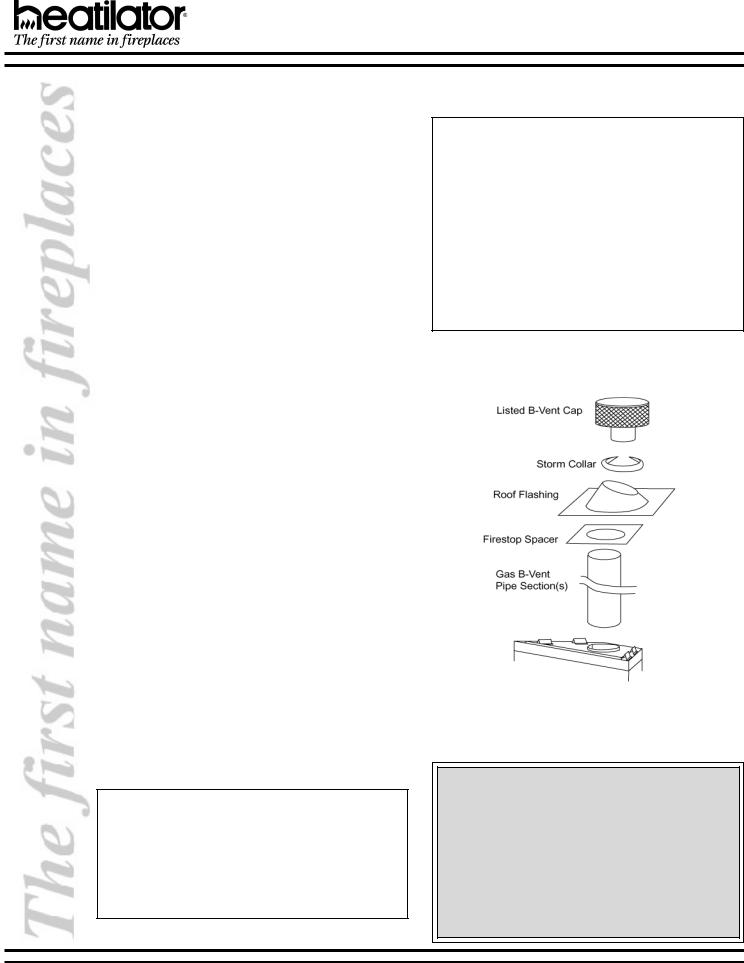
NOVUS B-VENT INSTALLATION INSTRUCTIONS
A. APPLICANCE SPECIFICATIONS
1.U.S. AND CANADA CERTIFICATION
The Novus B-Vent Gas Appliance has been tested in accordance with the ANSI standard Z21.88-2000. In Canada, the current CSA 2.33-2000, IR41, P4, and IR55 and have been LISTED by Underwriters Laboratories Inc. for installation as described in this manual. All components are UL, AGA, CGA or CSA safety certified.
2.LOCAL CODES
This installation must conform with local codes. In the absence of local codes comply with the National Fuel Gas Code ANSI Z223.1-latest edition in the U.S.A., and the CAN/CGA B149, Installation Codes in Canada.
For assistance during installation contact your local dealer or contact Heatilator Technical Services Department, Hearth & Home Technologies, 1915 W. Saunders Street, Mt. Pleasant, Iowa 52641, 1-800-843- 2848.
HEATILATOR® and NOVUS® are registered trademarks of Hearth & Home Technologies
3.GLASS SPECIFICATIONS/CERTIFICATIONS
Heatilator gas appliances manufactured with tempered glass may be installed in hazardous locations such as bathtub enclosures as defined by the CPSC. The tempered glass has been tested and certified to the requirements of ANSI Z97.1-1984 and CPSC 16 CFR 1202. (Safety Glazing Certification Council SGCC# 1595 and 1597. Architectural Testing, Inc. Reports 0231919.01 and 02-31917.01.)
This statement is in compliance with SPCS 16 CFR Section 1201.5 “Certification and labeling requirements” which refers to 15 USC 2063 stating “…Such certificate shall accompany the product or shall otherwise be furnished to any distributor or retailer to whom the product is delivered.”
Some local building codes require the use of tempered glass with permanent marking in such locations. Glass meeting this requirement is available from the factory. Please contact your dealer or distributor to order.
Note: Minimum and maximum clearances must be maintained at all times. Illustrations throughout these instructions reflect typical installations and are for design purposes only. Actual installation may vary slightly due to individual design preferences.
The illustrations and diagrams used throughout these installation instructions are not drawn to scale.
Tools and building supplies normally required for installation:
Tools: |
Building Supplies: |
Saw |
Wall-finishing materials |
Pliers |
Framing material |
Hammer |
Surround |
Phillips screwdriver |
Caulking material |
Tape measure |
|
Plumb line |
|
Level |
|
Electric drill/bits |
|
Square |
|
Gloves |
|
TYPICAL VERTICAL INSTALLATION
We strongly recommend that you DO NOT install B- Vent Gas Appliances in strong negative air locations, such as a basement or a public facility. Living rooms with cathedral ceilings could be susceptible to a negative air situation, but such installations can be overcome through raising the termination, depending on specific installations. This appliance uses room air for normal operation and could have problems establishing a positive draft in a negative air location. In lieu, we recommend a Direct Vent Gas Appliance.
34615 Rev G |
4 |
12-02 |
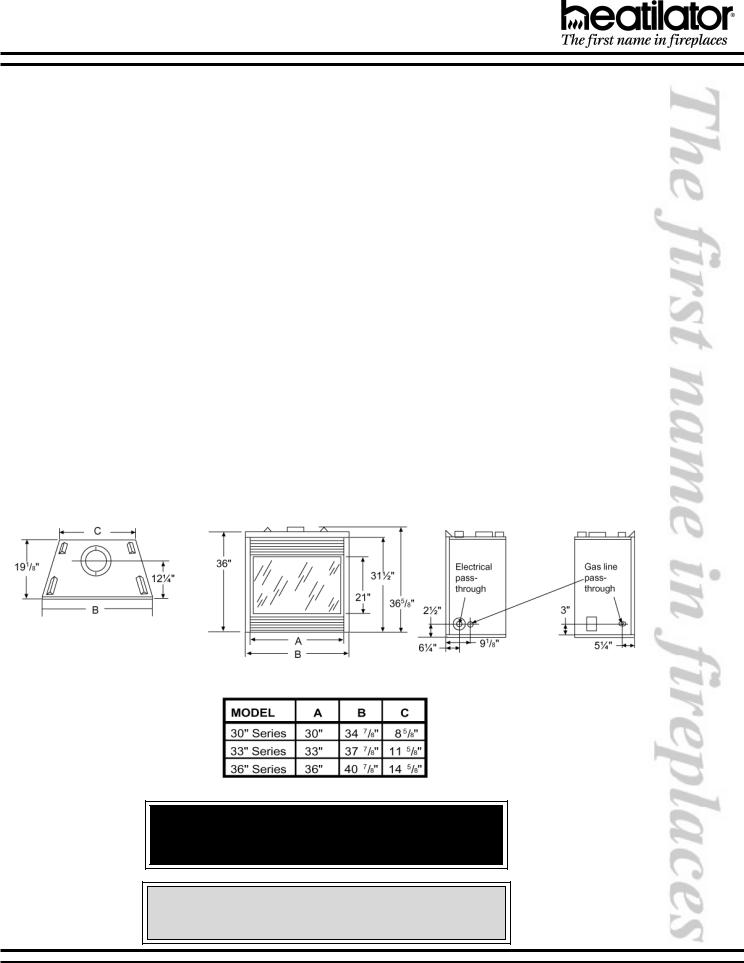
NOVUS B-VENT INSTALLATION INSTRUCTIONS
|
NOVUS NOMENCLATURE |
Catalog Number |
Description |
|
|
GNBC36LE |
Appliance Order Code Number |
GN |
Gas NOVUS |
B |
B-Vent |
C |
Circulating |
36 |
36 - 36" Appliance |
|
33 - 33" Appliance |
|
30 - 30" Appliance |
LE |
No suffix - Standing Pilot, Natural Gas |
|
L - Standing Pilot, Propane Gas |
|
E - Intermittent Pilot, Natural Gas |
|
LE - Intermittent Pilot, Propane Gas |
GNBC36LEB |
Appliance Order Code Number with Upgrade Code Number |
B |
Black Firebox |
F |
Fan Kit Upgrade |
GNBC36LEB |
EXAMPLE - Gas NOVUS, B-Vent, Heat Circulating, 36", Propane Gas, |
|
Intermittent Pilot Appliance with Black Firebox |
Installation Component |
Description |
|
|
AK14 |
Outside air kit (highly recommended - not supplied) |
|
|
B. LOCATION AND CLEARANCES
Appliance Dimensions
WARNING!
Due to high temperatures, the appliance should be located out of traffic and away from furniture and draperies.
CAUTION:
Do not expose appliance to the elements (such as rain, etc.).
12-02 |
5 |
34615 Rev G |
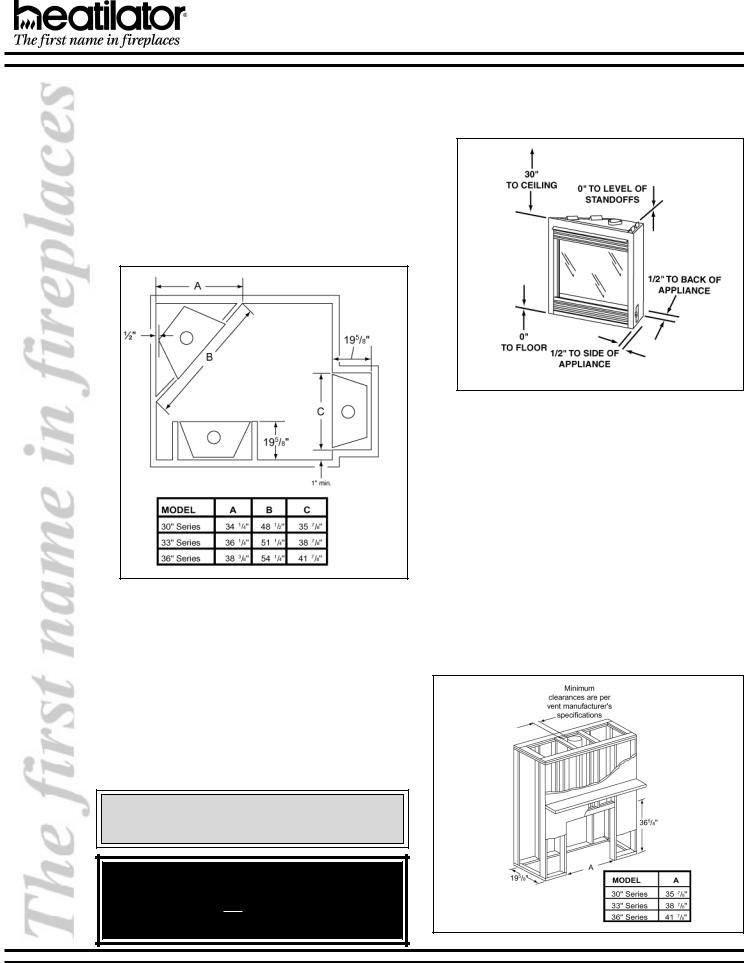
NOVUS B-VENT INSTALLATION INSTRUCTIONS
1.APPLIANCE LOCATIONS AND SPACE REQUIREMENTS
Figure 1 illustrates a variety of ways the appliance may be located in a room. The NOVUS Series may be installed directly on the floor or raised on a hearth. These appliances are certified for installation in a bedroom, bed/ sitting rooms or bathrooms in the U.S. and Canada, provided that the bedroom or bathroom has a volume of at least 1350 cubic feet.
Common venting of this gas appliance with other gas appliances is not allowed in multifamily dwellings.
Figure 1 - Appliance Locations
2.CLEARANCES
Figure 2 shows all clearances that must be maintained around the appliance.
Figure 2
Appliance Clearances to Combustible Materials
C. FRAMING
Figure 3 shows a typical framing of this appliance using combustible materials. All required clearances to combustibles must be adhered to. Mantel height is measured from the base of the appliance.
Mantel Projection |
Mantel Height |
|
|
9" to 12" |
41" |
6" to 9" |
39" |
3" to 6" |
38" |
0 to 3" |
36" |
|
|
CAUTION:
Wear gloves and safety glasses for protection.
WARNING!
To prevent contact with sagging or loose insulation, the appliance must not be installed against vapor barriers or exposed insulation.
Figure 3 - Framing
34615 Rev G |
6 |
12-02 |
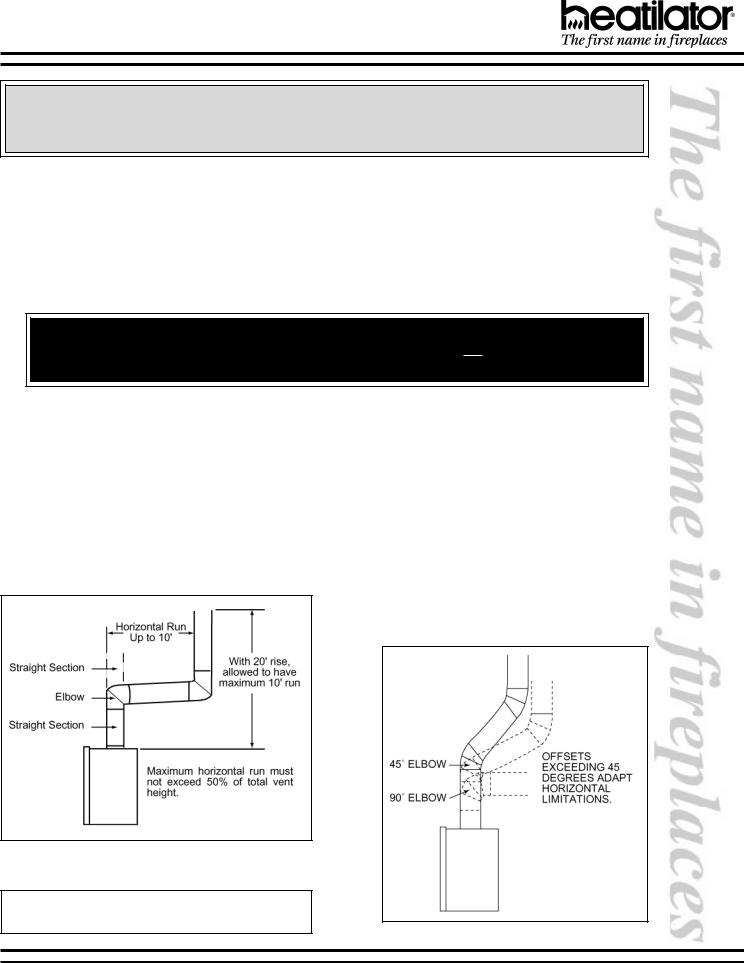
NOVUS B-VENT INSTALLATION INSTRUCTIONS
CAUTION:
Provide adequate clearances around the air openings into the combustion chamber and adequate accessibility clearances for servicing and proper operation.
D. SETTING THE APPLIANCE
This appliance may be placed on a smooth combustible or noncombustible, continuous flat surface. When the appliance is installed directly on carpeting, tile or other combustible material other than wood flooring, the appliance shall be installed on a metal or wood panel extending the full width and depth of the appliance. Slide the appliance into position and level the appliance from side-to-side and front-to-back. Shim with noncombustible materials as necessary.
Secure the appliance by bending out the nailing flanges on each side of the appliance and nail to framing. The nailing flanges have been positioned 5/8 inch back from the front of the appliance to allow the addition of drywall.
WARNING!
To prevent contact with sagging or loose insulation, the appliance must not be installed against vapor barriers or exposed insulation. Localized overheating could occur and a fire could result.
E. VENTING
1.VENT HEIGHT
This appliance requires a 5” B-vent for operation. Never downsize pipe. It must be terminated above the roof line. Follow all B-vent requirements and installation instructions, including minimum clearances.
The minimum height of vent installation must be nine feet from the top or twelve feet from the base of the appliance. Horizontal run must never exceed 50% of the height of the vent system as shown in Figure 4.
2.ATTACHING VENTING
a.Assembling Vent Sections. Attach straight vent section to the top of appliance. Use only B-vent sections.
b.Attaching the Vent to the Collar Shield. Three tabs extend from the collar shield to the B-vent section. Screw the tabs to the B-vent section using the self-tapping ¼” screws supplied with the appliance.
c.Using Elbows. Elbows exceeding 45° from the vertical shall be considered horizontal and therefore adapt horizontal run limitations. See Figure 5.
Figure 4
Venting Off the Top of Appliance
Note: Vertical rise off the top of the appliance before elbowing creates a less restrictive venting environment.
Figure 5 - Using Elbows
12-02 |
7 |
34615 Rev G |
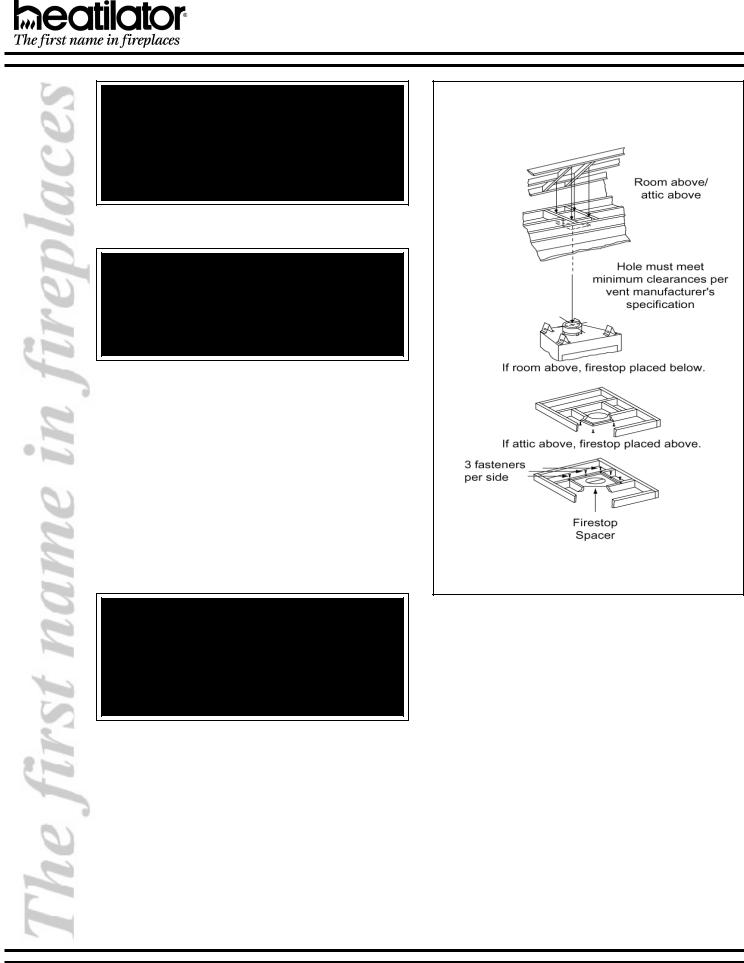
NOVUS B-VENT INSTALLATION INSTRUCTIONS
WARNING - RISK OF FIRE!
Always maintain minimum clearances or greater around the vent system. Do not pack air spaces with insulation or other material. The flow of combustion and ventilation air must not be obstructed.
WARNING!
The horizontal run of vent must have a 1/4” rise for every 1 ft. of run towards the termination. Never allow the vent to run downward. This could cause high temperatures and may present a fire hazard.
3.FIRESTOP SPACER/VENT INSTALLATION
Frame an opening and install a firestop spacer whenever the vent penetrates a ceiling floor area, as shown in Figure 6. Frame the opening with the same sized lumber as used in the ceiling/floor joist. Unless the flue is offset, the hole should be directly above the appliance. DO NOT pack insulation around the vent. Assemble vent sections with three screws per joint.
WARNING!
When vent sections exceeding three feet in length are installed between an offset/return, structural support must be provided to reduce off-center loading and prevent vent sections from separating at the vent joints. Follow all B-vent manufacturer guidelines.
Figure 6
Installing the Firestop Spacer
4.CHASE/TERMINATION INSTALLATION
Figure 7 and Table 1 specify minimum vent heights for various pitched roofs. Vent sections may have to be cut to a certain length.
These vent heights are necessary for safety and do not ensure draft-free operation. Trees, buildings, adjoining roof lines, adverse conditions, etc., may create a need for a taller vent should down drafting occur.
34615 Rev G |
8 |
12-02 |
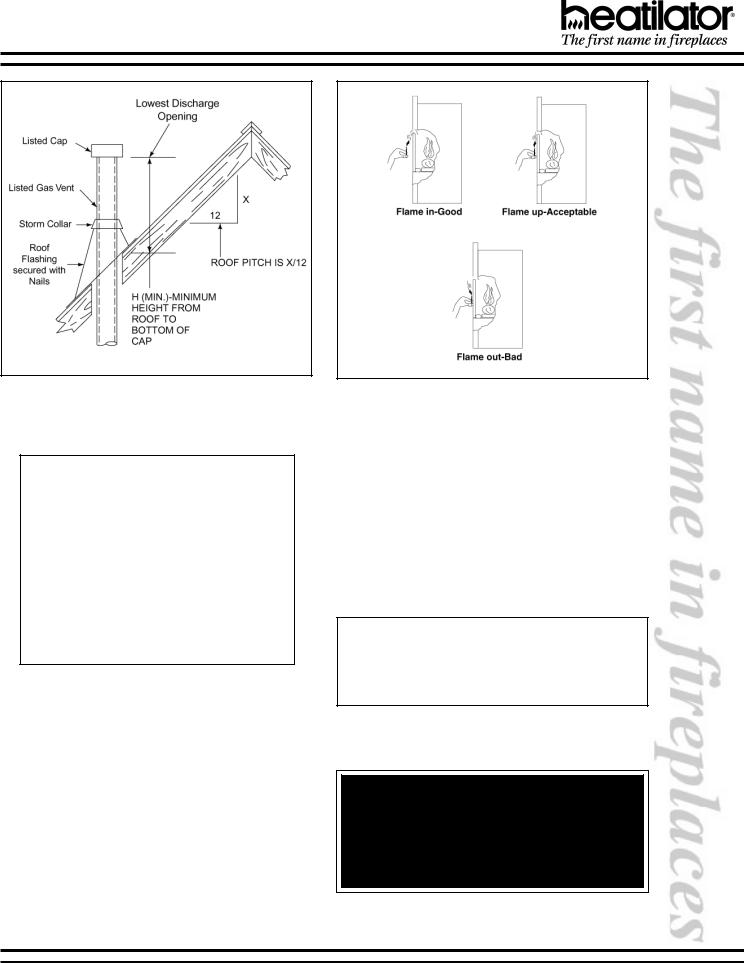
NOVUS B-VENT INSTALLATION INSTRUCTIONS
Figure 7
Vent Height for Vertical Termination
TABLE 1
Roof Pitch |
H (Min.) Ft. |
Flat to 6/12 ................................................ |
1.0 |
6/12 to 7/12 ............................................... |
1.25 |
Over 7/12 to 8/12 ...................................... |
1.5 |
Over 8/12 to 9/12 ...................................... |
2.0 |
Over 9/12 to 10/12 .................................... |
2.5 |
Over 10/12 to 11/12 .................................. |
3.25 |
Over 11/12 to 12/12 .................................. |
4.0 |
Over 12/12 to 14/12 .................................. |
5.0 |
Over 14/12 to 16/12 .................................. |
6.0 |
Over 16/12 to 18/12 .................................. |
7.0 |
Over 18/12 to 20/12 .................................. |
7.5 |
Over 20/12 to 21/12 .................................. |
8.0 |
Vent Height
5.CHECK VENTING SYSTEM
Check the venting system to assure proper operation. This can be done with a match while the appliance is operating.
Hold a lighted match at the bottom edge of the draft hood opening. If the flames and smoke remain upright, ventilation is acceptable. If the flames and smoke are drawn into the draft hood, this means ventilation is good. If the flames and smoke are forced away from the draft hood, this may indicate a ventilation blockage or down draft resulting in gas spillage into the home. If this occurs, turn off the appliance and do not burn it until it has been inspected by a qualified service person. See Figure 8.
Figure 8
Testing Ventilation
6.INSTALLING AN OUTSIDE AIR KIT (STRONGLY RECOMMENDED)
An outside air kit should be purchased as a feature with this appliance. An outside air kit helps to decrease the amount of room air taken by utilizing outside air for combustion. Figure 9 illustrates two of many possible methods that can be used to supply outside air to the appliance.
A maximum of 40’ of air kit ducting is allowed. The air kit must terminate at least one foot below the venting termination and must terminate to the outside.
Note: The outside air kit can terminate at any level with the exception that it must terminate at least one foot below the vent termination cap. The outside air kit inlet thimble should be positioned at least four feet above the ground level in a manner that will not allow snow, leaves, etc. to block the inlet.
WARNING!
Exhaust products of gasoline engines are hazardous. The outside air must not be taken from a garage space, attic spaces, basements or above the roofing where other heating appliances, fans or chimneys exhaust or utilize air.
12-02 |
9 |
34615 Rev G |
